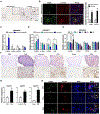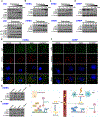Inhibition of heme-thiolate monooxygenase CYP1B1 prevents hepatic stellate cell activation and liver fibrosis by accumulating trehalose
- PMID: 39321267
- PMCID: PMC12084873
- DOI: 10.1126/scitranslmed.adk8446
Inhibition of heme-thiolate monooxygenase CYP1B1 prevents hepatic stellate cell activation and liver fibrosis by accumulating trehalose
Abstract
Activation of extracellular matrix-producing hepatic stellate cells (HSCs) is a key event in liver fibrogenesis. We showed that the expression of the heme-thiolate monooxygenase cytochrome P450 1B1 (CYP1B1) was elevated in human and mouse fibrotic livers and activated HSCs. Systemic or HSC-specific ablation and pharmacological inhibition of CYP1B1 attenuated HSC activation and protected male but not female mice from thioacetamide (TAA)-, carbon tetrachloride (CCl4)-, or bile duct ligation (BDL)-induced liver fibrosis. Metabolomic analysis revealed an increase in the disaccharide trehalose in CYP1B1-deficient HSCs resulting from intestinal suppression of the trehalose-metabolizing enzyme trehalase, whose gene we found to be a target of RARα. Trehalose or its hydrolysis-resistant derivative lactotrehalose exhibited potent antifibrotic activity in vitro and in vivo by functioning as an HSC-specific autophagy inhibitor, which may account for the antifibrotic effect of CYP1B1 inhibition. Our study thus reveals an endobiotic function of CYP1B1 in liver fibrosis in males, mediated by liver-intestine cross-talk and trehalose. At the translational level, pharmacological inhibition of CYP1B1 or the use of trehalose/lactotrehalose may represent therapeutic strategies for liver fibrosis.
Conflict of interest statement
Figures








References
-
- Tsochatzis EA, Bosch J, Burroughs AK, Liver cirrhosis. The Lancet 383, 1749–1761 (2014). - PubMed
-
- Senoo H, Yoshikawa K, Morii M, Miura M, Imai K, Mezaki Y, Hepatic stellate cell (vitamin A-storing cell) and its relative–past, present and future. Cell biology international 34, 1247–1272 (2010). - PubMed
-
- Tsuchida T, Friedman SL, Mechanisms of hepatic stellate cell activation. Nature reviews Gastroenterology & hepatology 14, 397 (2017). - PubMed
Publication types
MeSH terms
Substances
Grants and funding
LinkOut - more resources
Full Text Sources
Medical
Molecular Biology Databases

